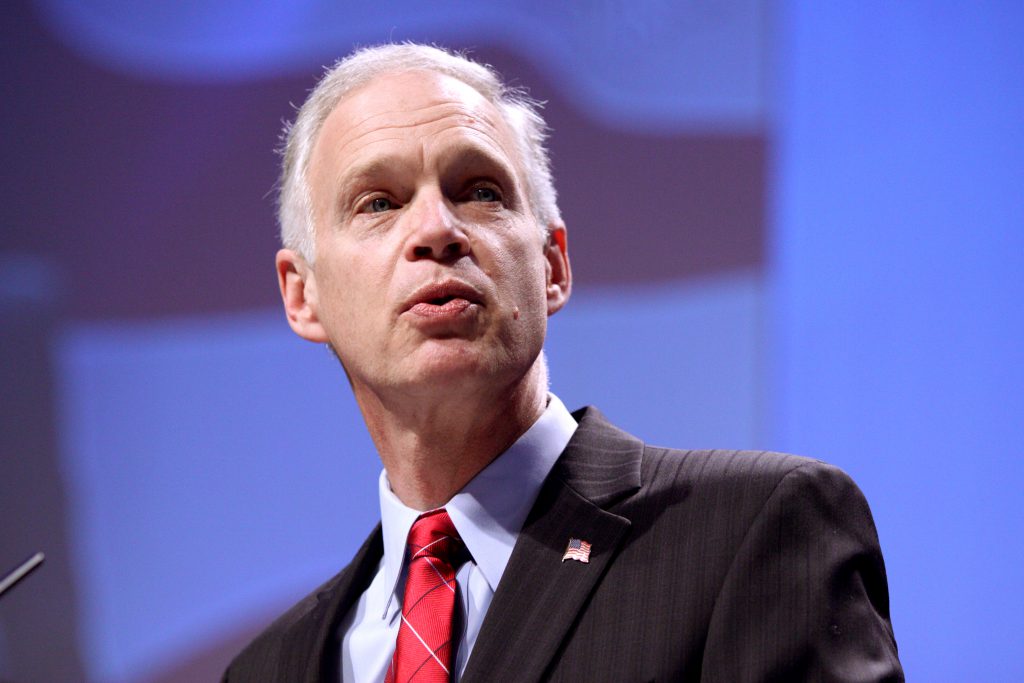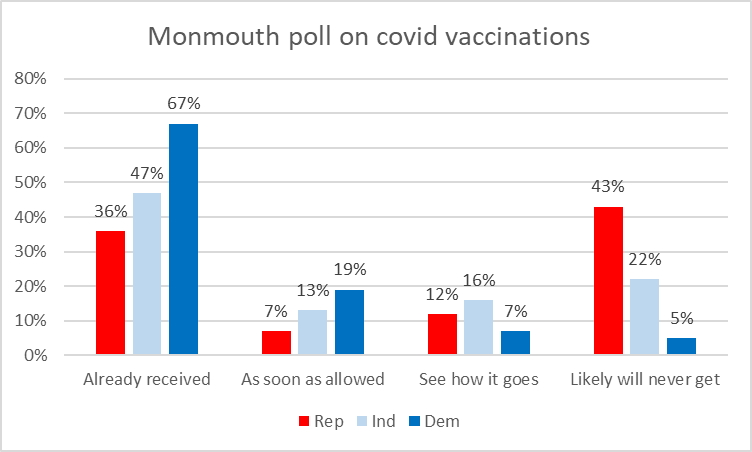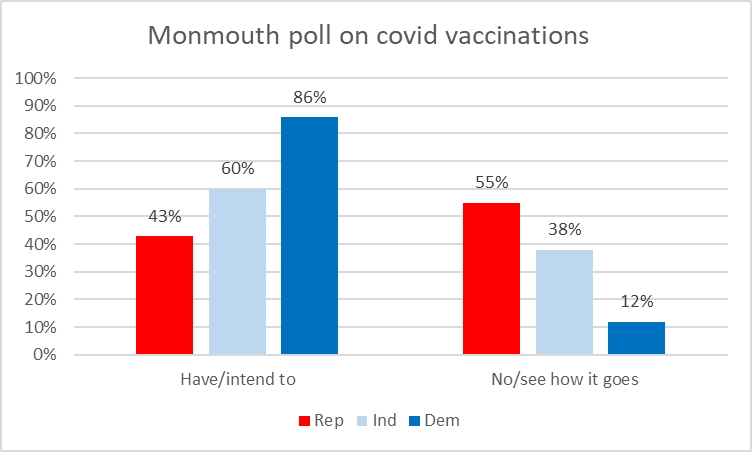Ron Johnson Threatens Republicans
Pandemic policies he pushes will cause the most deaths among Republican voters.

Ron Johnson. Photo by Gage Skidmore from Peoria, AZ, United States of America / Attribution-ShareAlike 2.0 Generic (CC BY-SA 2.0)
Tools for fighting the coronavirus have become surprisingly partisan. First, the issue was whether to wear masks to inhibit the spread of the virus. More recently the issue has centered on whether to be vaccinated against the disease.
A recent Monmouth College poll asked a sample of Americans whether they had received at least one dose of COVID-19 vaccine, planned to get the vaccine as soon as allowed, let others get it first to see how it goes, or would likely never get the vaccine. The pollsters commented that “partisanship remains the main distinguishing factor among those who want to avoid the vaccine altogether …” The graph below shows the response.
While two thirds of Democrats reported they had already received at least one dose, 43% of Republicans said they intended to never get the shot. The partisan influence is even greater when the two middle categories are combined, as shown below. While 86% of Democrats report that they have either received the vaccine or intend to, 55% of Republicans are vaccine skeptics.
This partisan polarization has been encouraged by a number of Republican politicians and commentators, including Wisconsin’s U.S. Senator Ron Johnson.
Phase 3 of the process of evaluating the proposed vaccines was aimed at measuring their effectiveness. An NIH report describes the trial for the Moderna vaccine. The trial began on July 27, 2020 and enrolled 30,420 volunteers. Half were randomly assigned to receive two doses of the Moderna vaccine and the others receive two shots of saline solution (called the placebo group) also 28 days apart. This is called a double-blind study because neither the volunteer nor the person administering the shot knew which was which.
In the Placebo group, there were 185 cases of COVID-19, and 30 (16%) of the cases were classified as severe. In the group receiving the vaccine, there were 11 cases, with none classified as severe.
Thus, the vaccine caused a 94.1% drop in infections. Put another way, the number of infections in the vaccine group was 5.9% that of the vaccine group.
Appearing with right-wing talk-show host Vicki McKenna, Johnson argued that:
The science tells us that vaccines are 95% effective, … So, if you have a vaccine, quite honestly, what do you care if your neighbor has one or not. … From my standpoint, because it’s not a fully approved vaccine, I think we probably should have limited the distribution to the vulnerable.
But 5.9% is not zero. While the vaccinated volunteers in the Moderna study had way less COVID-19 infections than those given a placebo, some still were infected. Thus, vaccinated people increase their risk if surrounded by unvaccinated people. The danger is particularly acute if society decides to drop all the rules meant to control the spread of the virus, such as wearing a mask and keeping distancing.
Consider the following thought experiment. Assume that when the virus first hit in early 2020, it was discovered that there was no need to develop new vaccines because existing vaccines were as effective against COVID-19 as those that appeared at the end of 2020 and there was sufficient supply to inoculate everyone. For any individual, the result of taking the vaccine is reduced to 5.9% compared to an unvaccinated person, assuming that there is no change in the incidence.
Applied to both ends of the infection transaction, 5.9% becomes 0.35%. In 2020, Wisconsin reported 520,438 cases of COVID-19, leading to 5,245 deaths. This calculation implies that with universal inoculations, there would have been only 1,840 cases and 19 deaths. More likely, the disease might have simply disappeared.
Mathematically, COVID-19 demonstrates exponential growth and decline. The graph below demonstrates both. Left of the first red shows exponential growth. In this, each generation was 10% larger than the previous one. For example, ten infected people on average infected eleven people.
To the right of the second red line the curve shows exponential decline. In this case ten infected people pass their infection to nine others.
The peak, between the red lines, shows a transition between growth and decline, in which the growth rate decreased by 2% every period until it became -10%.
Actual data show such growth and decline patterns. Consider Wisconsin’s historic record, as shown below. The extremely high late November peak dwarfs two earlier peaks, which at the time seemed alarmingly high.
The trick to turning exponential growth into exponential decline is to get the growth factor to something less than one, in which each generation of virus is less than its predecessor. In other words, to reduce transmission between people. Tools to do this include wearing masks, avoiding crowds, and vaccines. Of these, vaccines are the most effective and least disruptive.
However, vaccines are not perfect. As the Moderna and other studies show, inoculated people can still catch the virus. Thus, having a reservoir of unvaccinated people among whom the virus can spread and perhaps evolve into a variant that can resist the vaccine is bad for everyone.
However, the people most likely to act on Johnson’s dismissal of vaccines are Republicans, as shown by the Monmouth and other polls, who probably voted for him. To reward their support by pushing a policy that will increase their risk of sickness and deaths is truly a tragedy.
More about the Coronavirus Pandemic
- Governors Tony Evers, JB Pritzker, Tim Walz, and Gretchen Whitmer Issue a Joint Statement Concerning Reports that Donald Trump Gave Russian Dictator Putin American COVID-19 Supplies - Gov. Tony Evers - Oct 11th, 2024
- MHD Release: Milwaukee Health Department Launches COVID-19 Wastewater Testing Dashboard - City of Milwaukee Health Department - Jan 23rd, 2024
- Milwaukee County Announces New Policies Related to COVID-19 Pandemic - County Executive David Crowley - May 9th, 2023
- DHS Details End of Emergency COVID-19 Response - Wisconsin Department of Health Services - Apr 26th, 2023
- Milwaukee Health Department Announces Upcoming Changes to COVID-19 Services - City of Milwaukee Health Department - Mar 17th, 2023
- Fitzgerald Applauds Passage of COVID-19 Origin Act - U.S. Rep. Scott Fitzgerald - Mar 10th, 2023
- DHS Expands Free COVID-19 Testing Program - Wisconsin Department of Health Services - Feb 10th, 2023
- MKE County: COVID-19 Hospitalizations Rising - Graham Kilmer - Jan 16th, 2023
- Not Enough Getting Bivalent Booster Shots, State Health Officials Warn - Gaby Vinick - Dec 26th, 2022
- Nearly All Wisconsinites Age 6 Months and Older Now Eligible for Updated COVID-19 Vaccine - Wisconsin Department of Health Services - Dec 15th, 2022
Read more about Coronavirus Pandemic here
Data Wonk
-
Why Absentee Ballot Drop Boxes Are Now Legal
 Jul 17th, 2024 by Bruce Thompson
Jul 17th, 2024 by Bruce Thompson
-
The Imperial Legislature Is Shot Down
 Jul 10th, 2024 by Bruce Thompson
Jul 10th, 2024 by Bruce Thompson
-
Counting the Lies By Trump
 Jul 3rd, 2024 by Bruce Thompson
Jul 3rd, 2024 by Bruce Thompson

























I’m cool with less Republican voters.
A man without a conscience. Ask jerome smith. Oh nevermind.
Fewer current style R’s would be ok. I think the biggest concern with RoJo is that he behaves like he is just not smart. When you have Neanderthals like him, or Boebert or Taylor Greene in Washington, making policy, we are screwed.
The problem is that the RJ plan is to restrict more Democratic than Republican voters.